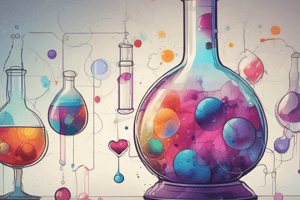Podcast
Questions and Answers
Which of the following compounds will show intramolecular hydrogen bonding?
Which of the following compounds will show intramolecular hydrogen bonding?
- H2O (correct)
- C2H5OH
- NH3
- All of the above
Which of the following is the least ionic compound?
Which of the following is the least ionic compound?
- CoCl2
- BaCl2
- KCl
- AgCl (correct)
Which of the following is a polar molecule?
Which of the following is a polar molecule?
- CCl4
- CHCl3 (correct)
- CO2
- CH2=CH2
Which of the following statements about noble gases is correct?
Which of the following statements about noble gases is correct?
Which of the following compounds have different symmetry about the molecular axis?
Which of the following compounds have different symmetry about the molecular axis?
Which of the following compounds will show intramolecular hydrogen bonding?
Which of the following compounds will show intramolecular hydrogen bonding?
Which molecule/ion has a square pyramidal shape?
Which molecule/ion has a square pyramidal shape?
In acidified aqueous solution, aluminum chloride forms an ion with which geometry?
In acidified aqueous solution, aluminum chloride forms an ion with which geometry?
How many molecules/ions exhibit a trigonal bipyramidal shape?
How many molecules/ions exhibit a trigonal bipyramidal shape?
Which molecule/ion does NOT have a trigonal bipyramidal shape?
Which molecule/ion does NOT have a trigonal bipyramidal shape?
What geometry does the molecule BrF5 exhibit?
What geometry does the molecule BrF5 exhibit?
What is the compound that forms a brown precipitate when passed through Nessler's reagent?
What is the compound that forms a brown precipitate when passed through Nessler's reagent?
In which of the following combinations do Fe, Mn, and Ni all appear together?
In which of the following combinations do Fe, Mn, and Ni all appear together?
Which of the following salts is white in color?
Which of the following salts is white in color?
On which date, in the given shifts, does Cr NOT appear?
On which date, in the given shifts, does Cr NOT appear?
How many shifts have 'A, B, C, and D' appearing together?
How many shifts have 'A, B, C, and D' appearing together?
Which shift has the highest number of different elements mentioned?
Which shift has the highest number of different elements mentioned?
Flashcards are hidden until you start studying
Study Notes
Chemistry
- The elements Fe, Mn, Ni, Cr, Cd are mentioned.
Gas 'X'
- Passing gas 'X' through Nessler's reagent produces a brown precipitate.
Salts
- White-colored salts are mentioned, with a total of 5.
- Examples of white-colored salts include:
- Ammonium sulphide
- Ammonium arsenomolybdate
- Lead sulphate
Molecular Symmetry
- Molecules with different symmetry about the molecular axis are mentioned.
Compounds
- The compound that is white in color is Lead sulphate.
Hydrogen Bonding
- Intra-molecular hydrogen bonding occurs in the compound o-Hydroxybenzoic acid.
Ionic Character
- The compounds CoCl2, KCl, BaCl2, and AgCl are compared for their ionic character.
- AgCl is the least ionic of these compounds.
Polar Molecules
- The molecules CCl4, CO2, CH2=CH2, and CHCl3 are compared for their polarity.
- CHCl3 is a polar molecule.
Noble Gases
- Noble gases are monoatomic gases held together by strong dispersion forces.
- Due to these forces, they are liquefied at very low temperatures and have high boiling points.
Molecular Shapes
- The molecule BrF5 has a square pyramidal shape.
- The molecule/ion PCl5 has a trigonal bipyramidal shape.
- Aluminium chloride in acidified aqueous solution forms an ion with an octahedral geometry.
- The molecule/ion [Ni(CN)4]2- has a square planar shape.
Molecular Orbitals
- The linear combination of atomic orbitals to form molecular orbitals takes place only when the combining atomic orbitals have the same symmetry about the molecular axis.
Studying That Suits You
Use AI to generate personalized quizzes and flashcards to suit your learning preferences.




